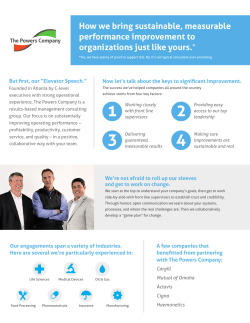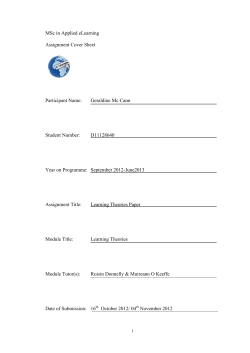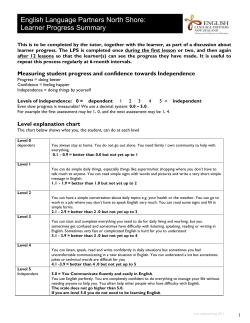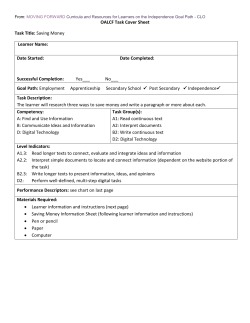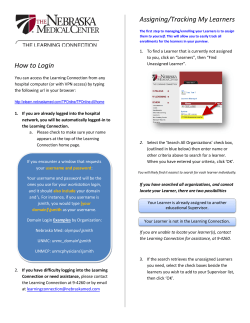
Learning Objectives
Learning Objectives A key component of adult learning is understanding what information or skill(s) participants will acquire by participating in an event or session. This can be achieved by using learning objectives. They are a clear, concise and specific statement of observable learner behaviours that can be assessed at the end of the learning activity(s). Learning objectives describe the intended purposes and expected results of learning activities and establish the foundation for assessment for all parties involved. Well-written objectives are specific and should be defined, observable, measurable and valid. They are not just a description of the content of the learning activity, but rather an outline of what a learner will be able to do differently as a result of the learning activity. They should be written from the learner's perspective and clearly describe the knowledge and skills that are significant for the learning activity, articulate what a satisfactory learner performance should be and describe in specific and measurable terms what the learner will be expected to know or be able to do as a result of engaging in the learning activity. A well written objective is carefully worded to include standards, conditions and terms which must be met and will describe: Performance What the learner should be able to do (a measurable verb) Conditions The conditions (if any) under which the learner will be able to achieve this (defined levels of accuracy, quality, quantity, time constraints) Standard How well the learning must be done (specify the acceptable degree of accuracy or proficiency that the learner must meet.) There are three types of learning objectives1 which reflect different aspects of learning: Cognitive objectives: “What do your learners need to know?” These are easy to measure and are commonly used. They involve factual knowledge, comprehension, application, analysis, synthesis and evaluation. Affective objectives: “What do your learners need to think or care about?” Good assessment for this type of objective is challenging to develop and difficult to assess, given the high need for subjectivity in assessment. They involve specific attitudes, beliefs, emotions or role expectations. Behavioural/skills objectives: “What do your learners need to be able to do?” These skills require practice and demonstration and are usually measured in terms of speed, precision, procedures or technique and involve using and coordinating the skeletal muscles including vision, hearing, speech or sense of touch. 1 Bloom, B. S.; Engelhart, M. D.; Furst, E. J.; Hill, W. H.; Krathwohl, D. R. (1956). Taxonomy of educational objectives: The classification of educational goals. Handbook I: Cognitive domain. New York: David McKay Company. For objectives to provide a useful basis for creating test questions, they must contain verbs that describe observable, measurable, achievable actions and specific levels of thinking, because these are things that can be tested. Avoid using verbs that represent actions or concepts that are difficult to measure – they are difficult to assess and to recognise whether the objective has been achieved. Measureable objectives allow transparent and accurate assessment of whether the objective has been achieved. Objectives that cannot be measured are vague and often result in the inability to objectively assess successful learning as any attempted assessment of these usually involves a lot of subjectivity. Many very worthwhile goals might be non-measurable but just because some goals are not quantifiable does not automatically make them less valuable; it just makes it harder to objectively determine the level of achievement. Short answer/MCQ assessments are unlikely to be able to do this successfully. There must be a direct relationship between the learning objectives and the assessment. The assessment should derive directly from the objectives and focus on important and relevant content. Trivia (even if it is interesting) does not need to be assessed. Effective learning objectives are: Consistent with the goals of the learning activity Clearly stated Clearly measurable Realistic and doable Appropriate for the level of the learner Define the important content How to create Learning Objectives Step 1 Learning objectives typically complete a statement. For example: At the end of this session, participants will be able to…. Upon completion of all activities, participants should be able to…. Step 2 Connect the statement created in the previous step to a measurable action verb. This should adequately describe what the participant should be able to know or do. Avoid using vague or abstract words such as believe, value, appreciate, be aware of, be familiar with etc. Examples: Measurable vs. Non-Measurable Terms Measurable - Non-Measurable - Use words like Avoid words like Identify Appreciate Compare/distinguish Be familiar with Justify Understand/comprehend Demonstrate Believe List Learn Describe Know Explain Be aware of Solve Realise the significance of Evaluate Have a good grasp of Step 3 End the sentence with the details of what the participant will be doing when they are demonstrating the verb. The detail should be specific and refer to the outcome of the learning objective. Example of Completed Learning Objectives 1. At the end of this session you should be able to: identify the signs, symptoms and complications of heart failure describe the investigations and clinical features used to diagnose heart failure describe the clinical management of patients with heart failure explain the non-pharmacological approaches to the treatment of heart failure 2. After completing this workshop you should be able to: explain the concept of patient-centred care describe the key communication and consultation skills and techniques required to conduct patient-centred care apply methods to assess your own practice and identify areas of improvement support patients, by using a patient-centred approach, to help them get the best from their medicines and/or in making healthy lifestyle choices
© Copyright 2025








